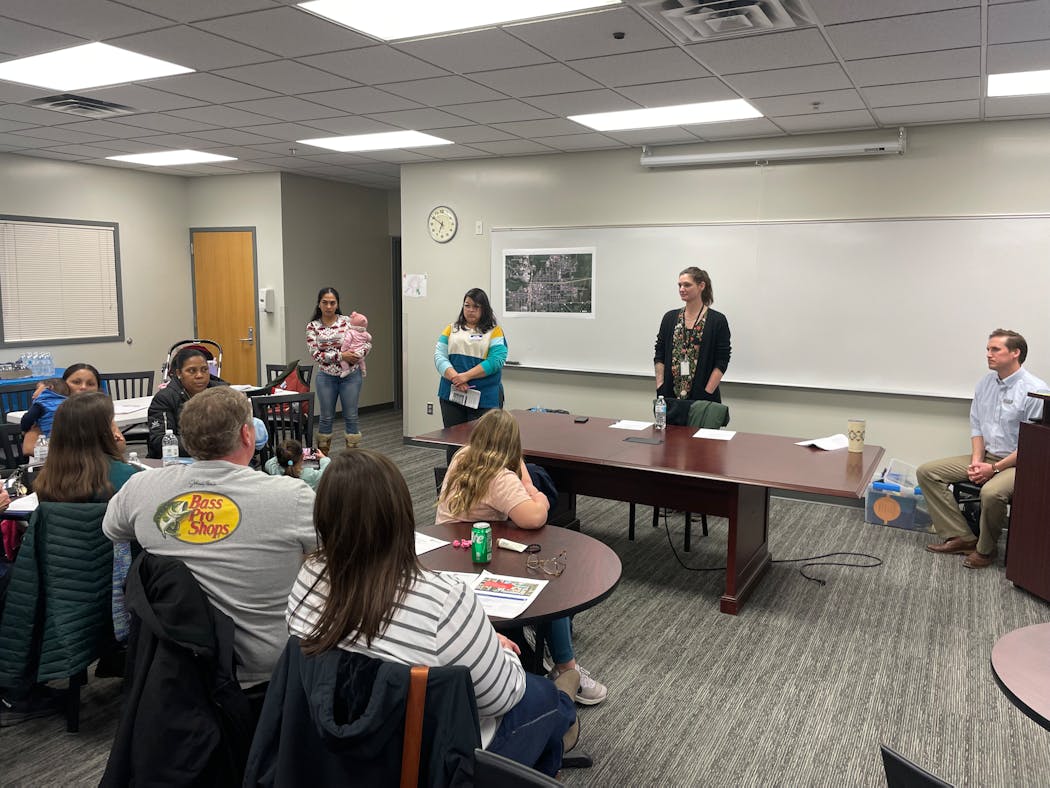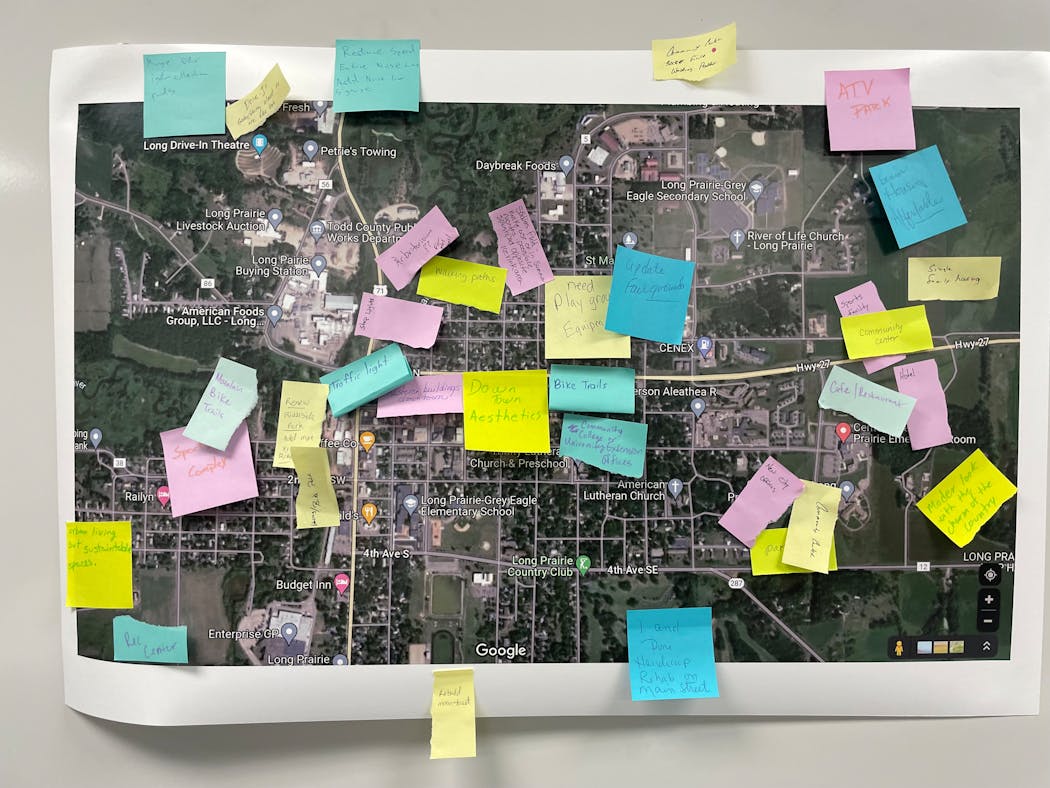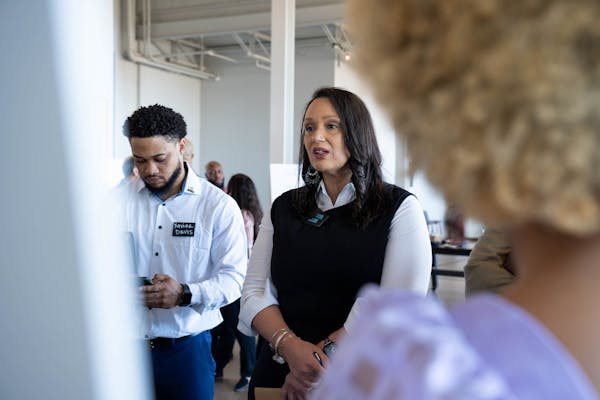About 30 residents in the central Minnesota town of Long Prairie met in a high school classroom one recent evening to begin work on a comprehensive economic development plan meant to last a decade or more.
They put sticky notes on maps and made lists of things they like and don't like about Long Prairie. A dislike brought up by several: the foul smells that sometimes emanate from the food processing plants in town.
Eight days before that, some of the same people clashed at a City Council meeting over a prospective tax break to the town's biggest employer, Long Prairie Packing Co., for building a 61-unit apartment complex for workers. A story about that meeting made the Star Tribune's front page, depicting racial antagonisms and suspicions about motives of the company and town leaders. The council tabled the tax break discussion.
The meeting on the comprehensive plan, meanwhile, had less drama than the two one-act plays being staged in another part of the high school that night.
Two meetings and two different moments do not tell the full story of a town of 3,700 people. They do show, however, that Long Prairie is grappling anew with the question that has dogged Americans throughout the country's history: Will our wallets or our prejudices guide the future?
"It's an embrace and also a fear of the unknown," Luan Thomas-Brunkhorst, director of the Long Prairie Area Chamber of Commerce, said in a chat before the meeting on the comprehensive plan.
While the Twin Cities area provides most of Minnesota's economic output, the leading edge of the fight to keep the state economy growing has long been in Long Prairie, Worthington, Austin and other towns dominated by slaughterhouses and vegetable processors. Over the last 40 years, the workforce in those firms shifted to immigrants, mainly from Mexico and countries in Central America. Which means that, before it was the case in the metro area, all of the population and economic growth in those towns was because of people of color.
Working through challenges of acceptance and acclimation became key to the economic survival of these towns. Now, it also matters to the economic health of Minnesota as the state experiences the slowest population growth in its history. Most of Minnesota's rural counties are expected to end the 2020s with fewer people than they began the decade.
Todd County, with Long Prairie as its seat, so far has been an exception. It has about 500 more people now than it did in 2020, Census Bureau figures show, with around 25,000 overall.
Just over one-third of Long Prairie's residents are Latino, and their economic power is growing. A few dozen former food-factory workers now own businesses in town. The chamber's guidebook is published in both Spanish and English. Latino students have been the majority in Long Prairie schools for the last two years. The district's elementary school teachers excel at getting Spanish-native kids proficient in English, test results show.
Two years ago, with help from the University of Minnesota Extension, Long Prairie opened a welcome center called the Wave/Saludos, where Spanish-speaking newcomers can learn about the community and make connections. Johanna Kegg leads it in a dual role as community health coordinator for Lakewood Health System.
A portion of her work involves helping expectant mothers, while another portion is helping people find work. She has blended the two at times, by helping young mothers become caregivers at senior homes around the area. "We are demonstrating to the community that language is not a barrier," Kegg said.
Finding a place to live in Long Prairie has been a challenge for decades, though. Verna Toenyan, who coordinates senior services for Todd County, told me she and her husband had difficulty finding a home when they arrived in 1977. These days, the chamber routinely fields calls from people looking for apartments, Thomas-Brunkhorst said. "We will call every single apartment in Long Prairie, and there is nothing," she said.
One reason is geography. Marshes surround a portion of the town, crimping its ability to build out in some directions. The bigger reason is economic. New housing is always expensive, and Long Prairie's employment base is dominated by workers in food factories earning $20 to $30 an hour. Some of them pass through the community quickly, and many send a portion of their earnings to relatives in other countries rather than spending it in Long Prairie.
"There's a lot of lower- to middle-income people, more than in a lot of other areas," said Trevor Zastrow, a banker in Long Prairie for 37 years. "We've got a great community and there are a lot of desirable things here. It's hard when you don't have housing. We have some rural areas where people have been able to build, but there's never been a lot done within the city."
At the economic development meeting, some attendees posted sticky notes labeled "housing" on the map over the northeast side of town where, over the last decade, a dozen houses were built. That's also where Long Prairie Packing initially wanted to build its apartment complex, though it ran into difficulties with sewer and road access.
In November, the Long Prairie City Council approved its construction in an industrial park instead. A plant manager told the council it didn't want to get into the housing business but "the market currently does not provide enough housing."
The maps at that kickoff meeting for the economic development plan — a 14-month process guided by the Region Five Development Commission, which works with communities in five central Minnesota counties — were covered with great ideas.
Some were practical. Long Prairie needs another stop light (it has just one) and maybe a roundabout, according to a couple of the notes. Some were vague. "Downtown aesthetics," read another.
The challenge for the community's volunteer planners is more fundamental. Long Prairie needs to attract more capital, which means it needs more outsiders to believe in the potential of its changed population.

Ramstad: Minnesota demographer takes deeper look at migration, workforce pressure
Ramstad: Health care is a tough arena for AI to make a difference
Ramstad: Misinterpreting data led me to the wrong conclusion about Minnesota retirees
Ramstad: How Rochester is keeping its housing growth on track





